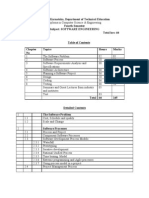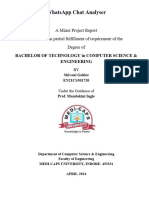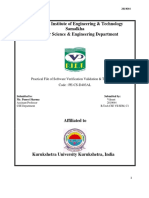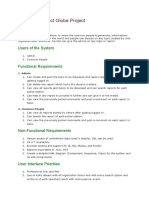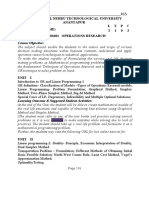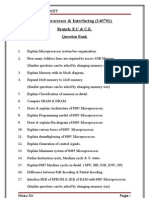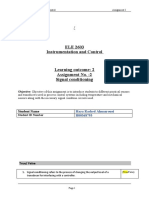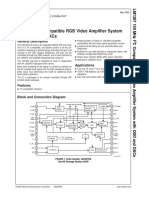Faculty of Informatics Department of Computer Science Course Title: Software Engineering
Faculty of Informatics Department of Computer Science Course Title: Software Engineering
Uploaded by
Daniel TekluCopyright:
Available Formats
Faculty of Informatics Department of Computer Science Course Title: Software Engineering
Faculty of Informatics Department of Computer Science Course Title: Software Engineering
Uploaded by
Daniel TekluOriginal Title
Copyright
Available Formats
Share this document
Did you find this document useful?
Is this content inappropriate?
Copyright:
Available Formats
Faculty of Informatics Department of Computer Science Course Title: Software Engineering
Faculty of Informatics Department of Computer Science Course Title: Software Engineering
Uploaded by
Daniel TekluCopyright:
Available Formats
ADMAS UNIVERSITY
FACULTY OF INFORMATICS
DEPARTMENT OF COMPUTER SCIENCE
Course Title: Software Engineering
Course Code: CoSc3061
Credit Hours: 3 Lecture Hours: 3
Laboratory Hours: - Prerequisites: CoSc3051
Course Description
This course provides an introduction to the problems of software development and
maintenance and the processes and methods used to address them. All phases in the software
development life cycle will be introduced. The course also deals with software project
planning, cost estimation, tracking and control, staffing, risk management, and software
configuration plan. Covers O-O concepts, tools, development life cycle, problem solving,
modeling, analysis, and design, while utilizing UML (Unified Modeling Language) for O-O
modeling. UML has become the standard notation for modeling O-O systems and is being
embraced by major software developers like Microsoft and Oracle.
Course Objectives
On completion of the course successfully, students will be able to:
➢ Understand the basic principles of Software Engineering
➢ Write requirements specification documents
➢ Design a system, component, or process to meet desired needs.
➢ Verify and validate a Software system practice with effective communication skill.
➢ Describe in detail the theory, concepts and methods pertaining to the
Unified Modeling Language(UML).
➢ Create requirements using use case modeling concepts.
➢ Demonstrate conceptual and technical skills in the analysis, design
and implementation of a software system using Object Oriented
Concepts.
➢ Employ tools and techniques for Object Oriented Software Engineering,
➢ Demonstrate an ability to adapt and solve problems in software
development activities from specification to testing individually and as
part of a team.
Course Content
Chapter 1: Introduction (6 hrs)
1.1. Two Orthogonal view of software.
1.2. Software development process models
1.2.1. Software Process
1.2.2. Software life cycle and process models
1.2.3. Process assessment models
1.2.4.Software process metrics
1.3. Object oriented system
development methodology.
1.3.1. Why an object oriented
1.3.2. Overview of
the unified approach.
1.3.3. An object
oriented philosophy
1.3.4.Basic concepts
of an object
1.3.5. Attributes of an object, its state and properties.
Chapter 2: Unified Modeling Language (UML) (8 hours)
2.1. Where Can the UML Be Used
2.2. Building Blocks of the UML.
2.3. Relationships in the UML
2.4. Diagrams in the UML.
2.4.1. Use Case Diagrams
2.4.2. Class Diagrams
2.4.3. Sequence diagrams
2.4.4. State chart diagrams
2.4.5. Activity diagrams
2.4.6. Component diagram
2.4.7. Deployment diagram
2.4.8. Diagram extensions
Chapter 3: Requirements Elicitation (6 hours)
3.1. An overview of requirements elicitation.
3.2. Requirements elicitation concepts
3.2.1.Functional requirements 3.2.2.Nonfunctional and pseudo requirements
3.2.3. Levels of description
3.2.4. Correctness, completeness, consistency, clarity, and realism
3.2.5. Verifiability and traceability
3.3. Requirements elicitation activities.
3.3.1. Identifying actors
3.3.2. Identifying scenarios
3.3.3. Identifying use cases
3.3.4. Refining use cases
3.3.5. Identifying relationships among actors and use cases
3.3.6. Identifying initial analysis objects
3.3.7. Identifying nonfunctional requirements
3.4. Managing requirements elicitation
3.4.1. Eliciting information from users:
3.4.2. Validating requirements: Usability testing
3.4.3. Documenting requirements elicitation
Chapter 4: Software Project management (6 hours)
4.1. Responsibility of Software Project Managers
4.2. Project Planning
4.3. The organization of SPMP document
4.4. Project Size Estimation Metrics
4.5. Project Estimation Techniques
4.6. Scheduling, Organization and Team Structures
4.7. Staffing
4.8. Risk Management
4.9. Quality Assurance
4.10. Project Monitoring Plans
Chapter 5: Analysis (8 hours)
5.1. Analysis Concepts
5.1.1. Entity, Boundary, and Control Objects
5.1.2. Association Multiplicity Revisited
5.1.3. Qualified Associations
5.1.4. Generalization
5.2. Analysis Activities: From Use Cases to Objects
5.2.1. Identifying Entity Objects
5.2.2. Identifying Boundary Objects
5.2.3. Identifying Control Objects
5.2.4. Modeling Interactions between Objects: Sequence Diagrams
5.2.5. Identifying Associations.
5.2.6. Identifying Attributes
5.2.7. Reviewing the Analysis Model
Chapter 6: Object Oriented System Design (8 hours)
6.1. An overview of system design.
6.1.1. System design concepts.
6.1.2. System design activities: From objects to subsystems
6.1.3. Documenting system design
6.1.4. An overview of object design
6.1.5. Object design concepts
6.1.6. Object design activities
6.1.7. Managing object design
6.1.8. Documenting object design
Chapter 7: Software Quality Assurance (6 hours)
7.1. An overview of testing
7.2. Testing concepts
7.3. Testing activities
7.4. Managing testing
7.5. Impact of object oriented testing
7.6. Types of Testing
Teaching Methods
- Lectures, Demonstration, Group Discussion
Method of Evaluation
- Test 1: 10%
- Test 2: 10%
- Project work: 10%
- Presentation: 10%
- Class Activity and Attendance: 10%
- Final exam: 50%
Textbook
- Brahmin, Ali (1999), Object oriented System development, McGraw Hill, USA.
References
- Martina Seidl, Marion Scholz, Christian Huemer, Gerti Kappel. UML @ Classroom: An
Introduction to Object-Oriented Modeling. 2012. Springer International Publishing AG.
- Scott, Kendall (2004) Fast Track UML 2.0 Apress USA
- Booch, Grady Rumbaugh, James Jacobson, Ivar (2005) The Unified Modeling Language
User Guide second edition Addison Wesley Professional USA
You might also like
- Circuit Diagram of Spot Welding Machine (tc15tc20) PDFDocument1 pageCircuit Diagram of Spot Welding Machine (tc15tc20) PDFWati Ka0% (1)
- Report Minor Project PDFDocument37 pagesReport Minor Project PDFSupratibh SaikiaNo ratings yet
- Computerized Crime Tracking Information PDFDocument74 pagesComputerized Crime Tracking Information PDFHarikumar RajandranNo ratings yet
- Project Report ON Autonomous Car System Using IOT: Submitted byDocument59 pagesProject Report ON Autonomous Car System Using IOT: Submitted bydilip kumar sahNo ratings yet
- Digital CalendarDocument58 pagesDigital Calendarmgitecetech100% (8)
- 00eCBKVF01Document40 pages00eCBKVF01milerkNo ratings yet
- 2020 Information Technolgoy Strategic Asset Management Plan: For "Information Technology (J-Org) "Document54 pages2020 Information Technolgoy Strategic Asset Management Plan: For "Information Technology (J-Org) "ratna dwiNo ratings yet
- Online Discussion Project ReportDocument75 pagesOnline Discussion Project Reportashley0% (1)
- Virtual Mouse Control Using Hand Class Gesture: Bachelor of Engineering Electronics and TelecommunicationDocument34 pagesVirtual Mouse Control Using Hand Class Gesture: Bachelor of Engineering Electronics and TelecommunicationGaurav MunjewarNo ratings yet
- Software EngineeringDocument8 pagesSoftware EngineeringVikram RaoNo ratings yet
- Software Engineering Interview Questions PDFDocument6 pagesSoftware Engineering Interview Questions PDFscatNo ratings yet
- Android Chat Application Documentation PDFDocument49 pagesAndroid Chat Application Documentation PDFArsalan rexNo ratings yet
- Major Project ReportDocument22 pagesMajor Project ReportRohini VhatkarNo ratings yet
- ProjectDocument25 pagesProjectARCHANA100% (1)
- Final Report Mini ProjectDocument45 pagesFinal Report Mini ProjectRishita MaheshwariNo ratings yet
- Face Detection System ReportDocument32 pagesFace Detection System ReportAnshu GuptaNo ratings yet
- Project Report (Online Growskills Platform)Document26 pagesProject Report (Online Growskills Platform)Contact VishalNo ratings yet
- TEACHING AND EVALUATION SCHEME FOR 5th Semester (CSE) (Wef 2020-21)Document25 pagesTEACHING AND EVALUATION SCHEME FOR 5th Semester (CSE) (Wef 2020-21)Bibhu Dutta MahapatraNo ratings yet
- Btech Final Year ProjectDocument47 pagesBtech Final Year ProjectRuchi SinghNo ratings yet
- Flying BallDocument25 pagesFlying BallSuhas.RNo ratings yet
- FYP Report TemplateDocument30 pagesFYP Report TemplateMazhar IqbalNo ratings yet
- Minor Project ReportDocument25 pagesMinor Project ReportAnamika Tripathi0% (1)
- Face Detection ReportDocument29 pagesFace Detection Report4GW18CS023 DivyaNo ratings yet
- Project Report AI Chatbot Covid 19Document28 pagesProject Report AI Chatbot Covid 19ISHA AWHALENo ratings yet
- SVVT Lab 2819044Document49 pagesSVVT Lab 2819044Prince KumarNo ratings yet
- Vsit Placement Cell App: Samson David Seat NumberDocument38 pagesVsit Placement Cell App: Samson David Seat NumbervivekNo ratings yet
- Real-Time Sign Language Detection and RecognitionDocument7 pagesReal-Time Sign Language Detection and RecognitionIJRASETPublicationsNo ratings yet
- SEPM Chapter 2 (Module 3)Document11 pagesSEPM Chapter 2 (Module 3)nsreek508No ratings yet
- Object RecognitionDocument46 pagesObject RecognitionElizabeth WeaverNo ratings yet
- A Facial Expression Recognition System A PDFDocument45 pagesA Facial Expression Recognition System A PDFmian mahadNo ratings yet
- Malware - Detection - Using - Machine - Learning (3) - RemovedDocument31 pagesMalware - Detection - Using - Machine - Learning (3) - RemovedMANISH KUMAR SINGH SVNITNo ratings yet
- SMS Spam Detection Using Machine LearningDocument9 pagesSMS Spam Detection Using Machine LearningNishant KhandharNo ratings yet
- CSE35 Project ReportDocument111 pagesCSE35 Project ReportSrinadh ReddyNo ratings yet
- Secure Vault Mobile ApplicationDocument62 pagesSecure Vault Mobile ApplicationMegha Kulkarni100% (1)
- Synopsis PDocument6 pagesSynopsis PPooja Choudhary100% (1)
- Bachelor of Technology in Department of Information Technology & EngineeringDocument51 pagesBachelor of Technology in Department of Information Technology & EngineeringTanishkaNo ratings yet
- Ooad Record AbinashDocument241 pagesOoad Record AbinashRAM KUMAR SNo ratings yet
- Final Project ReportDocument52 pagesFinal Project ReportB VAMSI KRISHNA REDDYNo ratings yet
- Projectreport 121202043850 Phpapp02Document120 pagesProjectreport 121202043850 Phpapp02Narayan LokeNo ratings yet
- Movie Recommendation System Using Machine LearningDocument23 pagesMovie Recommendation System Using Machine Learning29sfw4rvjmNo ratings yet
- Project Synopsis (127, 128, 136)Document24 pagesProject Synopsis (127, 128, 136)ac5712916No ratings yet
- 6 2D Platformer Report PDFDocument68 pages6 2D Platformer Report PDFassNo ratings yet
- Facial Recognition Attendence SystemDocument45 pagesFacial Recognition Attendence SystemArunesh SharmaNo ratings yet
- Visvesvaraya Technological University: BELAGAVI-590018Document25 pagesVisvesvaraya Technological University: BELAGAVI-590018Pruthvi ReddyNo ratings yet
- Whatsapp Chat Analyzer Project ReportDocument34 pagesWhatsapp Chat Analyzer Project Reportsoumyaranjan4104No ratings yet
- Resume Screening Report (1) - MergedDocument43 pagesResume Screening Report (1) - MergedShivansh Singhal100% (1)
- Control Systems FINAL REPORTDocument20 pagesControl Systems FINAL REPORTSOHAN SARKAR 20BEC0767No ratings yet
- JSPM'S Bhivrabai Sawant Polytechnic, Wagholi 2022 - 2023: Department of Computer EngineeringDocument28 pagesJSPM'S Bhivrabai Sawant Polytechnic, Wagholi 2022 - 2023: Department of Computer Engineeringyash kaleNo ratings yet
- File 4Document60 pagesFile 4AVADHESH CHAMOLANo ratings yet
- Social Networking SitesDocument160 pagesSocial Networking SitesNishith SahaniNo ratings yet
- Face Emotion Recognition Using Python Project 19nr1ao595Document44 pagesFace Emotion Recognition Using Python Project 19nr1ao595Abdullah AnsariNo ratings yet
- Connect Globe Project: Objective/ VisionDocument11 pagesConnect Globe Project: Objective/ VisionHarshitha100% (1)
- Social Media User Database ManagmentDocument25 pagesSocial Media User Database ManagmentSHIVANSH KASHYAP (RA2011003010988)No ratings yet
- Comprehensive VivaDocument9 pagesComprehensive VivaSAURABH KUMAR PANDEY Research Scholar, Chemical Engg. & Technology , IIT(BHU)No ratings yet
- Project Report Text Editor in JavaDocument10 pagesProject Report Text Editor in JavaKuldeep Sharma100% (1)
- JNTUA-B.Tech.3-2 MECH-R15-SYLLABUSDocument36 pagesJNTUA-B.Tech.3-2 MECH-R15-SYLLABUSSanskrithi Sanskrithi 12No ratings yet
- Front-End Developer AssessmentDocument2 pagesFront-End Developer AssessmentAbhishek RawatNo ratings yet
- Vigash Mini ProjectDocument75 pagesVigash Mini ProjectKaran SinghNo ratings yet
- Celonis Internship ReportDocument11 pagesCelonis Internship ReportEssu KandulaNo ratings yet
- Virtual Assistant SynopsisDocument6 pagesVirtual Assistant SynopsiskhushankNo ratings yet
- Chatbot AbstractDocument6 pagesChatbot AbstractAshiru FemiNo ratings yet
- Project Report PDFDocument29 pagesProject Report PDFTejas BaseshankarNo ratings yet
- Rapid Application Development A Complete Guide - 2019 EditionFrom EverandRapid Application Development A Complete Guide - 2019 EditionNo ratings yet
- Two-Ports NetworksDocument24 pagesTwo-Ports NetworksMohammadNo ratings yet
- IOT Based Smart Environment MonitoringDocument19 pagesIOT Based Smart Environment MonitoringDEBASHISH PARIDANo ratings yet
- ClientDocument12 pagesClientargentynskiepesossNo ratings yet
- RESTful Web API Design With Node - Js - Second Edition - Sample ChapterDocument17 pagesRESTful Web API Design With Node - Js - Second Edition - Sample ChapterPackt Publishing0% (1)
- Home Automation System Using ArduinoDocument5 pagesHome Automation System Using ArduinoKayeNo ratings yet
- PDM 10Document10 pagesPDM 10Rober ChicoNo ratings yet
- Kylin SATA Arch DraftDocument34 pagesKylin SATA Arch DraftАндрашNo ratings yet
- Operating Systems: Chapter ThreeDocument32 pagesOperating Systems: Chapter ThreeFitawu TekolaNo ratings yet
- Module 1 StudentsDocument59 pagesModule 1 StudentsMahesh M P NairNo ratings yet
- DNS Servers, Roles and Functions: Domain Name ServicesDocument24 pagesDNS Servers, Roles and Functions: Domain Name ServicesziaullahNo ratings yet
- ZTURNLITESCHV11Document13 pagesZTURNLITESCHV11M. T.No ratings yet
- Kongo Mhoro-Swahili Ndovu BoqDocument2 pagesKongo Mhoro-Swahili Ndovu BoqHamza MazoNo ratings yet
- Router Vs SwitchDocument2 pagesRouter Vs SwitchKaustubh ParkerNo ratings yet
- Slide NavigationDocument3 pagesSlide Navigationapi-26617115No ratings yet
- PCNE WorkbookDocument83 pagesPCNE WorkbookhiNo ratings yet
- Microprocessor Question BankDocument4 pagesMicroprocessor Question BankDarshan SharmaNo ratings yet
- Service Manual: DBVT1341 Series ADocument64 pagesService Manual: DBVT1341 Series AsugedaNo ratings yet
- 5 Nano 2022 Conference TemplateDocument5 pages5 Nano 2022 Conference TemplateHemanth PragadaNo ratings yet
- TRAICDocument14 pagesTRAICManav JainNo ratings yet
- Chapter 1Document30 pagesChapter 1Aditya RanaNo ratings yet
- ELE 2603 AssignmentDocument16 pagesELE 2603 AssignmentハヤNo ratings yet
- LV Upgrade NotesDocument12 pagesLV Upgrade NotesAjeet BhartiNo ratings yet
- LM1267NA DatasheetDocument22 pagesLM1267NA DatasheetacorkeryuNo ratings yet
- Mosfet Drive With OptocouplerDocument13 pagesMosfet Drive With OptocouplerManjit KumarNo ratings yet
- Info OrdenadorDocument38 pagesInfo OrdenadorArantzazu Velasco QuintanaNo ratings yet
- Software Development Applying Model-Based Design Process & ToolsDocument18 pagesSoftware Development Applying Model-Based Design Process & Toolsgamecel90No ratings yet









